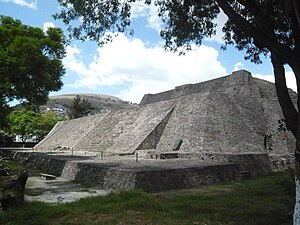Tenayuca
| Pyramid of Tenayuca | |
|---|---|

The Aztec pyramid of Tenayuca
|
|
| Basic information | |
| Location | Greater Mexico City. |
| Geographic coordinates | 19°31′55.8″N 99°10′6.5″W / 19.532167°N 99.168472°W |
| Municipality | Tlalnepantla de Baz |
| State | Mexico State |
| Region | Valley of Mexico |
| Status | preserved, with museum |
| Website | Tenayuca at INAH (Spanish) |
| Architectural description | |
| Architectural type | Temple |
| Architectural style | Aztec |
| Specifications | |
| Direction of façade | West |
| Length | 52 meters |
| Width | 60 meters |
Tenayuca (Nahuatl: tenanyōcān) is a pre-Columbian Mesoamerican archaeological site in the Valley of Mexico. In the Postclassic period of Mesoamerican chronology, Tenayuca was a settlement on the former shoreline of the western arm of Lake Texcoco. It was located approximately 10 kilometres (6.2 mi) to the northwest of Tenochtitlan (the heart of present-day Mexico City).
Tenayuca is considered to be the earliest capital city of the Chichimec, nomadic tribes who migrated and settled in the Valley of Mexico, where they formed their own kingdoms.
Tenayuca means walled place in Nahuatl.
The pyramid of Tenayuca is located in San Bartolo Tenayuca in Tlalnepantla de Baz, in Mexico State. It falls within the urban sprawl of Greater Mexico City.
By some historiographic traditions Tenayuca had been founded ca. 1224 by Xolotl, a semi-legendary ruler of a "Chichimec" tribe that had settled in the Valley of Mexico in the period some time after the 12th-century collapse of the former political hegemony in the Valley — the so-called Toltec empire, emanating from Tula. Xolotl was succeeded by Nopaltzin who consolidated the Chichimec Kingdom . His son, Tlotzin, became lord of Tenayuca. When Nopaltzin died, his successor Quinatzin transferred the seat of Chichimec power to Texcoco, relegating Tenayuca to a site of secondary importance.
However archaeological remains recovered from Tenayuca indicate that the site had already been occupied in the Classic Period, long before this foundational event described in several of the Mesoamerican historical documents. Its population increased in the early Postclassic and continued to increase after the fall of Tula, when Tenayuca became an important regional power.
...
Wikipedia
